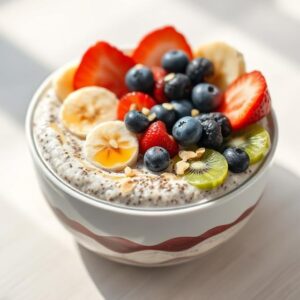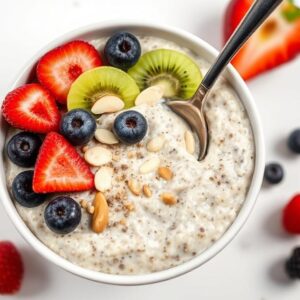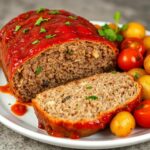In the fast-paced world we live in, finding a breakfast that is both healthy and convenient can feel like a challenge. That’s where overnight oats come in — a simple, delicious, and customizable meal that supports your weight loss goals while saving time in the morning. Overnight oats are not only easy to prepare but also packed with fiber, protein, and essential nutrients that keep you full and energized throughout the day.
Whether you’re trying to shed a few pounds or simply aiming to eat healthier, this article will walk you through everything you need to know about overnight oats for weight loss, including why they work, how to make them, customization tips, and frequently asked questions from health-conscious eaters just like you.
What Are Overnight Oats?
Overnight oats are a no-cook method of preparing oatmeal. Instead of cooking your oats on the stove or in the microwave, you mix rolled oats with liquid (usually milk or yogurt) and let them soak overnight in the refrigerator. This allows the oats to absorb the liquid and soften, creating a creamy texture that’s ready to eat by morning.
The best part? You can customize your overnight oats with a wide variety of healthy toppings, from fresh fruits to seeds and nuts, depending on your preferences and dietary needs.
Why Are Overnight Oats Good for Weight Loss?
There are several reasons why overnight oats are ideal for anyone trying to lose weight:
-
High in Fiber: Rolled oats are a great source of dietary fiber, especially beta-glucan, which helps you feel full longer and supports digestion.
-
Supports Portion Control: Prepping your oats in a jar or bowl allows you to manage your portion sizes more effectively.
-
Low in Calories but Nutrient-Dense: When prepared with the right ingredients, overnight oats offer a lot of nutrition with relatively few calories.
-
Stabilizes Blood Sugar: The combination of complex carbs, fiber, and protein can help keep blood sugar levels steady, reducing cravings and overeating.
-
Convenient for Meal Prep: Having your breakfast ready to go reduces the temptation to reach for less healthy options in the morning.
Basic Overnight Oats Recipe for Weight Loss
Here’s a simple base recipe that you can customize to your liking:
Ingredients:
-
½ cup rolled oats
-
½ cup unsweetened almond milk (or any low-calorie milk alternative)
-
2 tablespoons Greek yogurt (optional for added creaminess and protein)
-
1 teaspoon chia seeds
-
A pinch of cinnamon
-
Fresh fruits for topping (berries, banana, or apple slices)
-
Natural sweetener (like stevia or a drizzle of honey) – optional
Instructions:
-
In a jar or bowl, mix the rolled oats, milk, yogurt, chia seeds, and cinnamon.
-
Stir until well combined.
-
Seal and refrigerate overnight, or for at least 4 hours.
-
In the morning, top with your favorite fruits and enjoy.
You can easily double or triple the recipe and prepare several jars at once for the week ahead.
Customizing Your Overnight Oats
The beauty of overnight oats is how easily they can be tailored to your taste and dietary goals. Here are a few healthy add-ins to consider:
-
Protein Boosters: Add protein powder, Greek yogurt, or nut butter to increase satiety.
-
Fruits: Use fresh, frozen, or dried fruits like berries, apples, bananas, mango, or raisins.
-
Seeds and Nuts: Chia seeds, flaxseeds, almonds, walnuts, or sunflower seeds add healthy fats and crunch.
-
Flavor Enhancers: Try vanilla extract, unsweetened cocoa powder, or spices like nutmeg and cardamom.
When choosing toppings, aim for whole, natural ingredients that are low in added sugars and high in nutrients.
Common Mistakes to Avoid
If you’re new to overnight oats, here are a few things to watch out for:
-
Using Too Much Liquid: This can make your oats watery and unappetizing. Start with a 1:1 ratio and adjust from there.
-
Adding Sweeteners Excessively: It’s easy to turn a healthy breakfast into a sugar bomb. Stick with natural options and use them sparingly.
-
Forgetting the Protein: For a truly balanced breakfast, always include some form of protein.
-
Skipping the Soaking Time: The oats need a few hours to soften. Don’t rush it — overnight soaking yields the best results.
When Is the Best Time to Eat Overnight Oats?
Overnight oats are typically eaten for breakfast, but they also make an excellent pre- or post-workout snack. Their slow-digesting carbohydrates and fiber make them ideal for providing sustained energy without the crash.
Can Overnight Oats Be Made in Advance?
Yes, overnight oats are perfect for meal prep. You can make them in advance and store them in the fridge for up to five days. Just keep in mind that softer fruits (like bananas) may become mushy over time, so consider adding those the night before or in the morning.
Are Overnight Oats Gluten-Free?
Oats are naturally gluten-free, but they are often processed in facilities that also process wheat. If you are sensitive to gluten or have celiac disease, make sure to use certified gluten-free oats.
Frequently Asked Questions About Overnight Oats for Weight Loss
1. Can overnight oats help me lose belly fat?
While no food specifically targets belly fat, overnight oats support overall weight loss which can contribute to fat reduction, including around the belly.
2. How many calories are in a serving of overnight oats?
A basic serving is around 250–350 calories, depending on ingredients used. You can adjust it based on your calorie goals.
3. Can I eat overnight oats every day?
Yes, overnight oats are safe and healthy to eat daily if your ingredients are balanced and varied.
4. Should I eat overnight oats hot or cold?
You can eat them cold straight from the fridge or warm them in the microwave for a minute if preferred.
5. Are overnight oats better with milk or yogurt?
Both are great options. Milk creates a thinner consistency, while yogurt adds creaminess and protein.
6. Can I make overnight oats without chia seeds?
Yes, chia seeds are optional. They add texture and nutrition but aren’t required.
7. How long do overnight oats last in the fridge?
Typically, they last up to five days when stored in a sealed container.
8. Can I use steel-cut oats instead of rolled oats?
Steel-cut oats require more soaking time and result in a chewier texture. Rolled oats are better for a smooth, ready-to-eat consistency.
9. What’s the best fruit for overnight oats?
Berries, apples, bananas, and mangoes are all excellent choices. They add flavor, color, and nutrients.
10. Are overnight oats good for diabetics?
Yes, when made with unsweetened ingredients and balanced with protein and fiber, they can help manage blood sugar levels.
11. Do overnight oats cause bloating?
Some people may experience bloating due to fiber. Start with smaller portions if you’re new to oats.
12. Can I make overnight oats with water?
Yes, though the texture will be less creamy. You can mix water with a bit of yogurt or use plant-based milk for better taste.
13. Should I add the toppings before or after refrigerating?
For best texture, add toppings like fruits and nuts in the morning before eating.
14. Can I use flavored yogurt in overnight oats?
Yes, but watch out for added sugars. Greek yogurt is best for protein and low sugar content.
15. Is it okay to add protein powder?
Absolutely. Protein powder is a great way to make overnight oats more filling and support muscle maintenance during weight loss.
Conclusion
Overnight oats are more than just a trendy breakfast idea — they are a practical and nutritious solution for anyone looking to eat healthier, save time, and support weight loss. By using wholesome ingredients, customizing your flavors, and planning ahead, you can enjoy a delicious meal that nourishes your body and keeps you on track with your wellness goals.
If you’re ready to start your journey with healthy eating, overnight oats are the perfect place to begin. Their visual appeal, convenience, and health benefits make them ideal for sharing — so don’t forget to save, pin, and share this recipe with your friends.
For more inspiring recipes like this, follow us on Pinterest and stay updated with fresh, colorful ideas to keep your meals exciting and nourishing every day.



